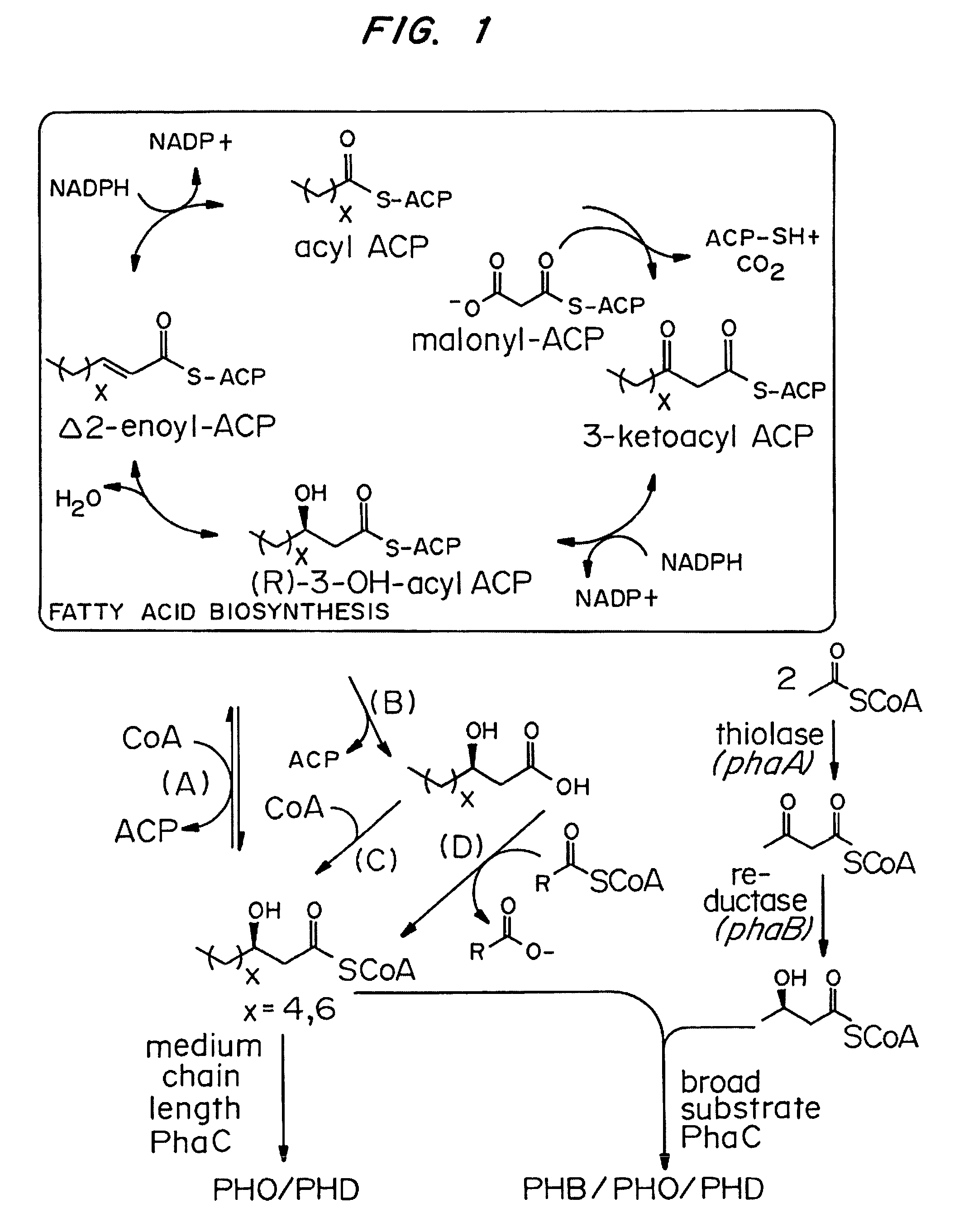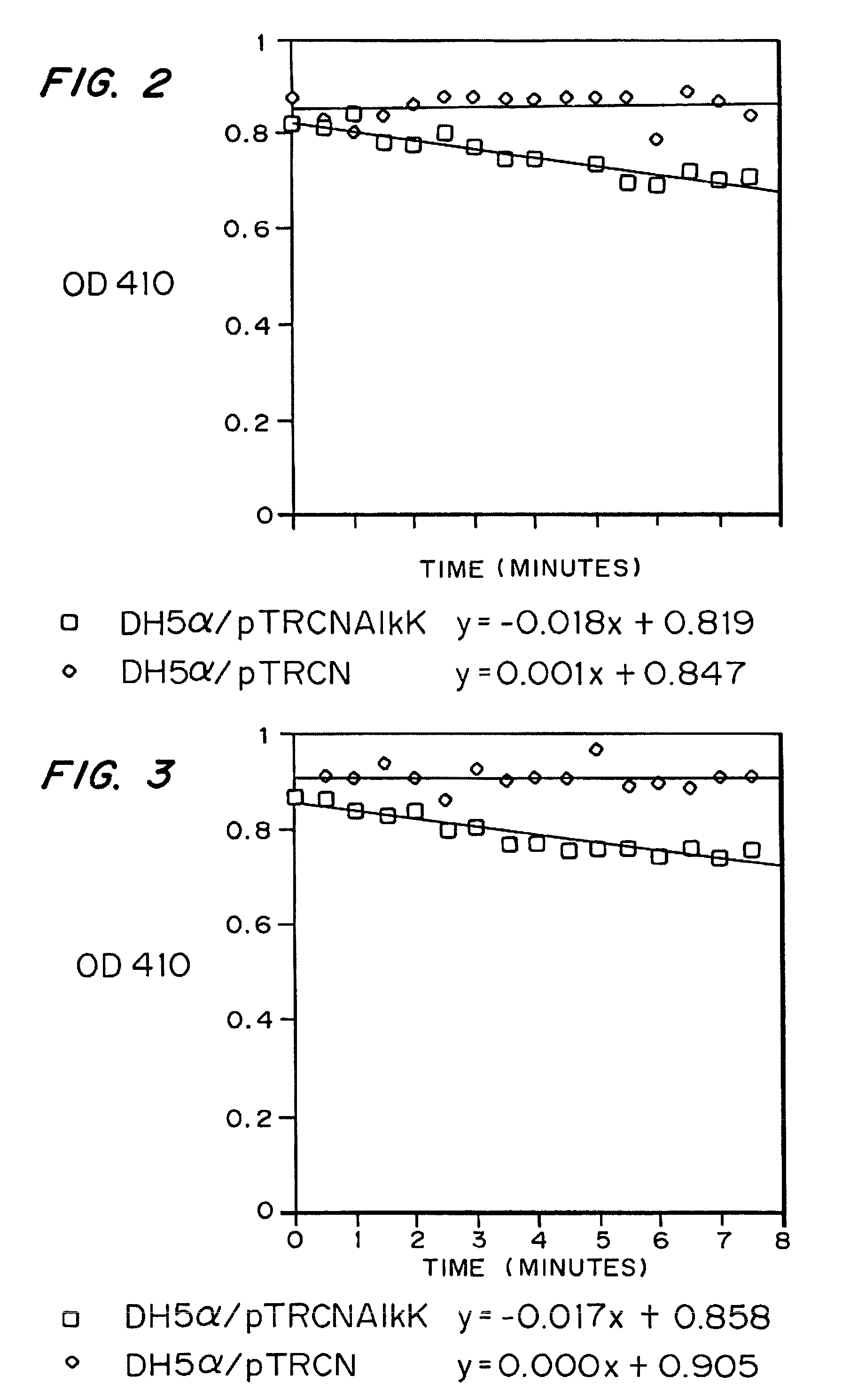Production of medium chain length polyhydroxyalkanoates from fatty acid biosynthetic pathways
- Summary
- Abstract
- Description
- Claims
- Application Information
AI Technical Summary
Benefits of technology
Problems solved by technology
Method used
Image
Examples
example 1
Construction of E. coli Expression Cassettes for PhaG and PhaC
[0051]The gene encoding PhaG was isolated by PCR from Pseudomonas putida genomic DNA using primers phaGF-EcorI and phaGR-KpnI and cloned into the EcoR I and Kpn I sites of the E. coli expression vector pTRCN forming plasmid pMTX-phaG. The sequence of the phaG insert in pMTX-phaG (SEQ ID NO:9) was found to be identical to the sequence listed in Genbank (Accession #AF052507).
[0052]
EcoRI RBS annealing regionPrimer phaGF-EcorI5′ ggaattc aggagg ttttt atgaggccagaaatcgctgtacttg3′(SEQ ID NO: 1) Kpn I annealing regionPrimer phaGR-KpnI5′ ggggtaccctcagatggcaaatgcatgctgcccctgc3′(SEQ ID NO: 2)
[0053]Plasmid pSU18-KPS1.2N #3, expressing synthase 1 from Pseudomonas oleovorans, was constructed from plasmid pKPS 1.2 using a multi-step procedure as follows. Plasmid pKPS1.2 contains phaC with its native ribosome binding site in vector pKK223-3 (Amersham Pharmacia Biotech, Piscataway, N.J.). The fragment is equiva...
example 2
Production of 3-Hydroxyoctanoic Acid and 3-Hydroxydecanoic Acid in Recombinant E. coli Strains Expressing PhaG and PhaC
[0059]In an attempt to produce PHA in E. coli using glucose as a carbon source, host strain JM109 (Promega, Madison, Wis.) was transformed with plasmids selected from the following group: pSU-PhaC.P.o.trc.PhaG (medium chain length synthase and PhaG expression plasmid), pSU18 (control vector for pSU-PhaC.P.o.trc.PhaG), and pTRCN (plasmid into which additional genes could be inserted). Starter cultures (5 mL) of JM109 / pTRCN / pSU18 and JM109 / pSU-PhaC.P.o trc.PhaG were inoculated with a single colony into LB medium (Difco) containing ampicilin (100 mg / L) and chloramphenicol (25 mg / L). The cultures were grown at 30° C. overnight. The starter cultures were diluted (1:100) into LB medium (5 mL) containing ampicilin and chloramphenicol and grown for 10 hours at 30° C. with agitation at 250 RPM. The cultures were harvested and the cells were washed two times with 2.5 mLs of m...
example 3
Construction of E. coli Expression Cassette for PhaG, PhaC, and Acyl CoA Synthetase (AlkK)
[0062]A PhaG catalyzed conversion of 3-hydroxyacyl ACPs to free fatty acids (FIG. 1, Route B) instead of 3-hydroxyacyl CoAs (FIG. 1, Route A) could provide one explanation for the observation of 3-hydroxyacyl butyl esters in GC chromatograms of derivitized culture supernatants from E. coli strains expressing PhaG and PhaC. In the E. coli accumulation studies described in Example 2, the native E. coli acyl CoA synthetase may not have been induced in the minimal medium growth conditions employed due to repression of transcription of the gene encoding the acyl CoA synthetase (fadD) by FadR, an E. coli protein that functions as a transcriptional regulator (Black, P. N., DiRusso, C. C., Metzger, A. K., Heimert, T. L. J. Biol. Chem. 1992, 267, 25513-25520). Alternatively, FadD may not have substrate specificity for medium chain length 3-hydroxy fatty acids.
[0063]To test whether the addition of an acy...
PUM
| Property | Measurement | Unit |
|---|---|---|
| Molar density | aaaaa | aaaaa |
| Fraction | aaaaa | aaaaa |
| Fraction | aaaaa | aaaaa |
Abstract
Description
Claims
Application Information
 Login to View More
Login to View More - R&D
- Intellectual Property
- Life Sciences
- Materials
- Tech Scout
- Unparalleled Data Quality
- Higher Quality Content
- 60% Fewer Hallucinations
Browse by: Latest US Patents, China's latest patents, Technical Efficacy Thesaurus, Application Domain, Technology Topic, Popular Technical Reports.
© 2025 PatSnap. All rights reserved.Legal|Privacy policy|Modern Slavery Act Transparency Statement|Sitemap|About US| Contact US: help@patsnap.com



